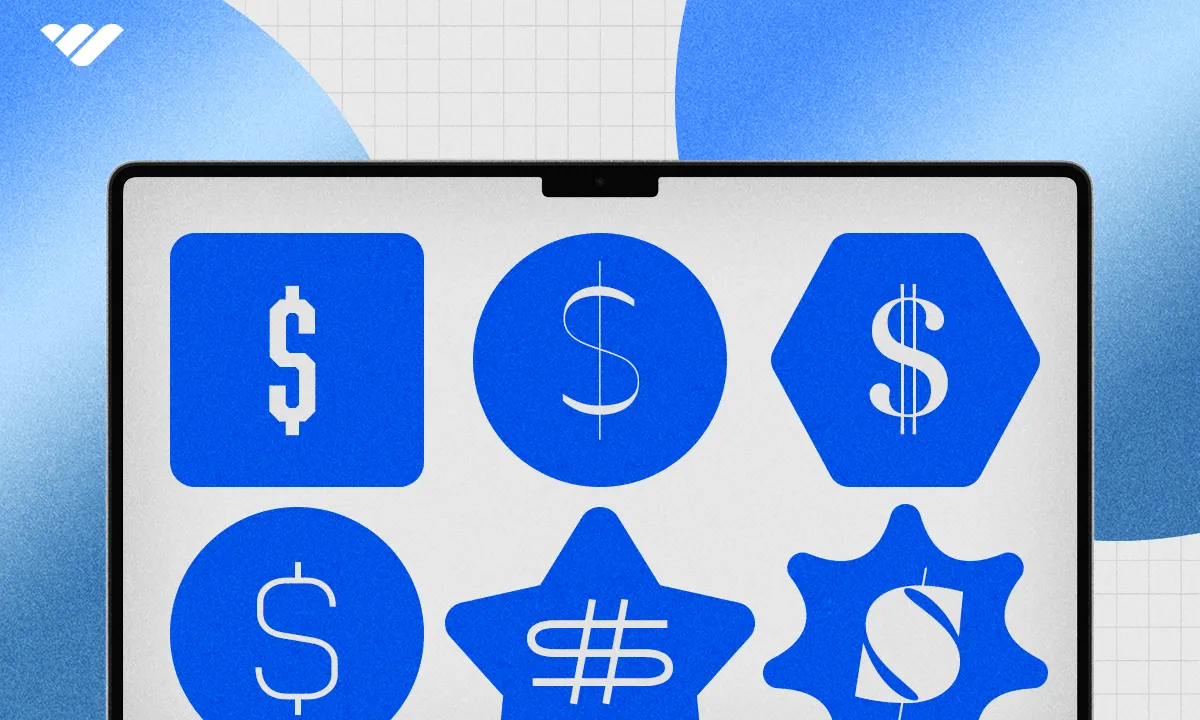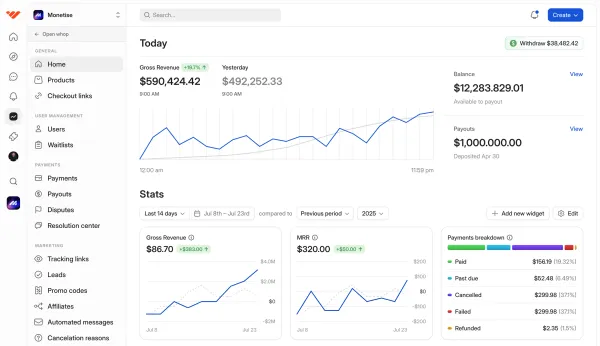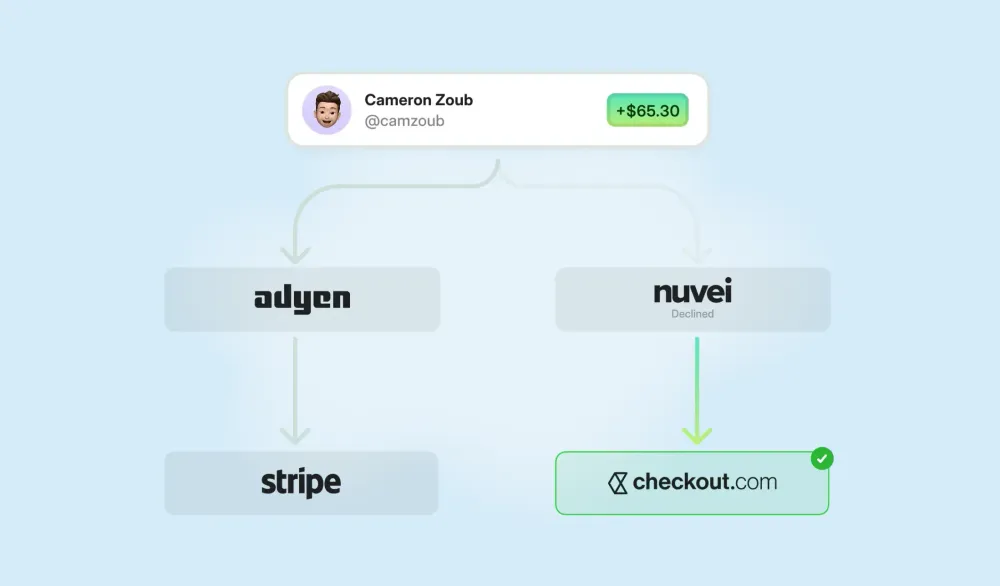What's the difference between a freelancer making six-figures and one who is just scraping by? Diversification. Read this guide and learn how you can diversify your income as a freelancer.
Key takeaways
- Successful freelancers build multiple revenue streams to avoid feast or famine cycles.
- Expanding services upward through tiers and packages prevents overwhelming service sprawl.
- Digital products can generate $30,000+ annually as passive income sources for freelancers.
- One-to-one coaching requires being just one step ahead of your students.
- Teaching and consulting offer high-value, low-commitment alternatives to hands-on client work.
Are you a freelancer struggling to cope with the uncertainty of your next paycheck?
You’re not alone.
Freelancing has many benefits: you can set your own hours, choose who you work with, and there’s no glass ceiling to your earnings.
But there’s a downside. You don’t always know when you’ll land your next client and the gaps between projects can loom over you.
This is why I heavily encourage freelancers to branch out and diversify their income.
In this piece, I’ll walk you through ways to expand your income as a freelancer—from new services to passive income products and beyond. You’ll discover practical strategies for making money on your own terms and creating income channels that don’t depend on a packed client roster.
The truth about making money as a freelancer
I’ve been freelancing for over a decade now and, let me tell you, it’s not always smooth sailing. My income has been up and down more times than my hopes and dreams—there’s a reason the phrase “feast or famine” is so closely attached to freelancing.
One month you might be swimming in projects. The next, it’s crickets. This ebb and flow is totally normal, but it highlights why relying on a single income stream as a freelancer can be very risky.
I now know that the most successful freelancers build multiple revenue streams. It’s something I’ve done myself, too. Over the years, I’ve expanded my service offerings, added passive income sources to my repertoire, and diversified the type of client I work with.
This means I no longer rely on any one source of income. If one dries up completely, I’m not up the creek without a paddle. Instead, I can fall back on another revenue stream (or two) until I’m out of murky waters.
How to diversify your income
The good news is, there are many ways you can generate passive income as a freelancer—you already have the skills, tools, and knowledge you need to succeed.
1. Expand what you offer
When you’re a freelancer you learn a lot of skills.
Over the years, I’ve picked up SEO knowledge, email marketing skills, and all sorts of other talents I can now offer clients. I’d urge all freelancers to add new skills and services to their arsenal—but not in a way that feels overwhelming.
At the start of my freelance career, I offered everything (and I mean, everything), from social media posts, website copy, admin, data entry, email marketing, blog post writing, and all sorts of other comms-based tasks. But it quickly became overwhelming and the sheer range of things I offered blurred the lines for a lot of my clients.
Now, instead of expanding my services outwards by adding more of the same, I expand my services upwards, so I’m offering different tiers and packages. For example, as well as writing content for clients, I also plan content strategies and offer hour-long consults.
Think about how you can build on your current skills to add new services—and remember, not every revenue stream has to be hands-on work or time-intensive projects.
Consulting
If you have in-depth knowledge in your field, offering consulting services can be a high-value, low-commitment revenue stream. Instead of doing the work yourself, you can guide others to the results they want through strategic advice and planning sessions.
For example, Eman Ismail offers an email consultancy session alongside her other services.
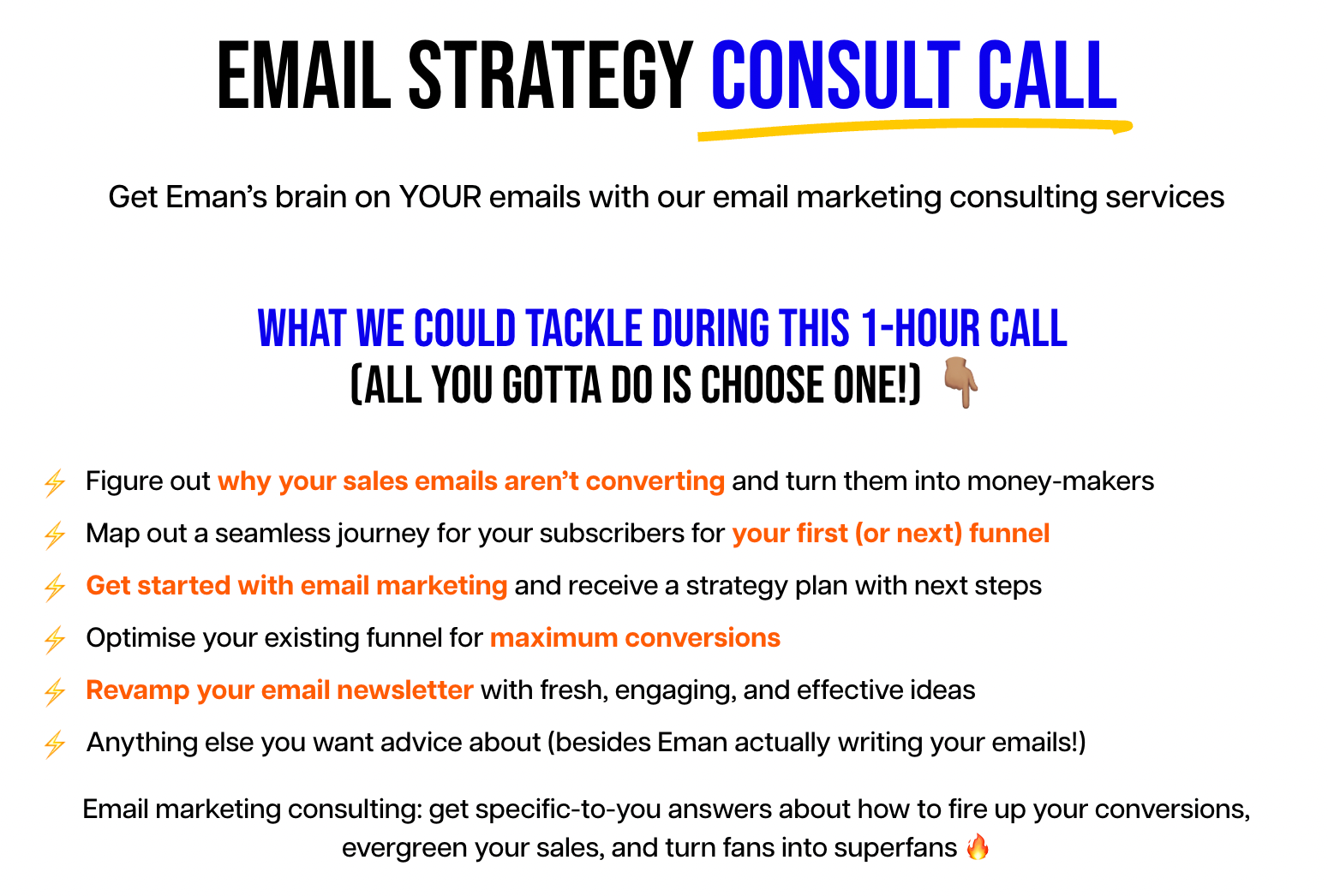
Webinars and workshops
I know plenty of freelancers who visit clients in person to deliver training. This is a great way to share your expertise without long-term time commitments. You don’t have to do it in person, though. You can hold live webinars instead, or create evergreen recordings that sell repeatedly over time.
Tip: position your training around specific challenges, like building a content calendar in a day or learning how to do keyword research.
Audits
Offering audits is another excellent way to use your knowledge in a one-off service that’s often high-ticket and an entry point to your other services. For example, if you’re a social media expert, you might offer Instagram profile audits. Or, if you’re an SEO specialist, you might run website audits that seamlessly tie into your long-term services.
I find audit-type services particularly useful if you have trouble getting clients to commit. It’s a low-touch option that gives them a sneak peek into what it’s like to work with you, and you can end the audit with some actionable advice and a segue into your other services.
Freelancer James Taylor offers technical website audits.
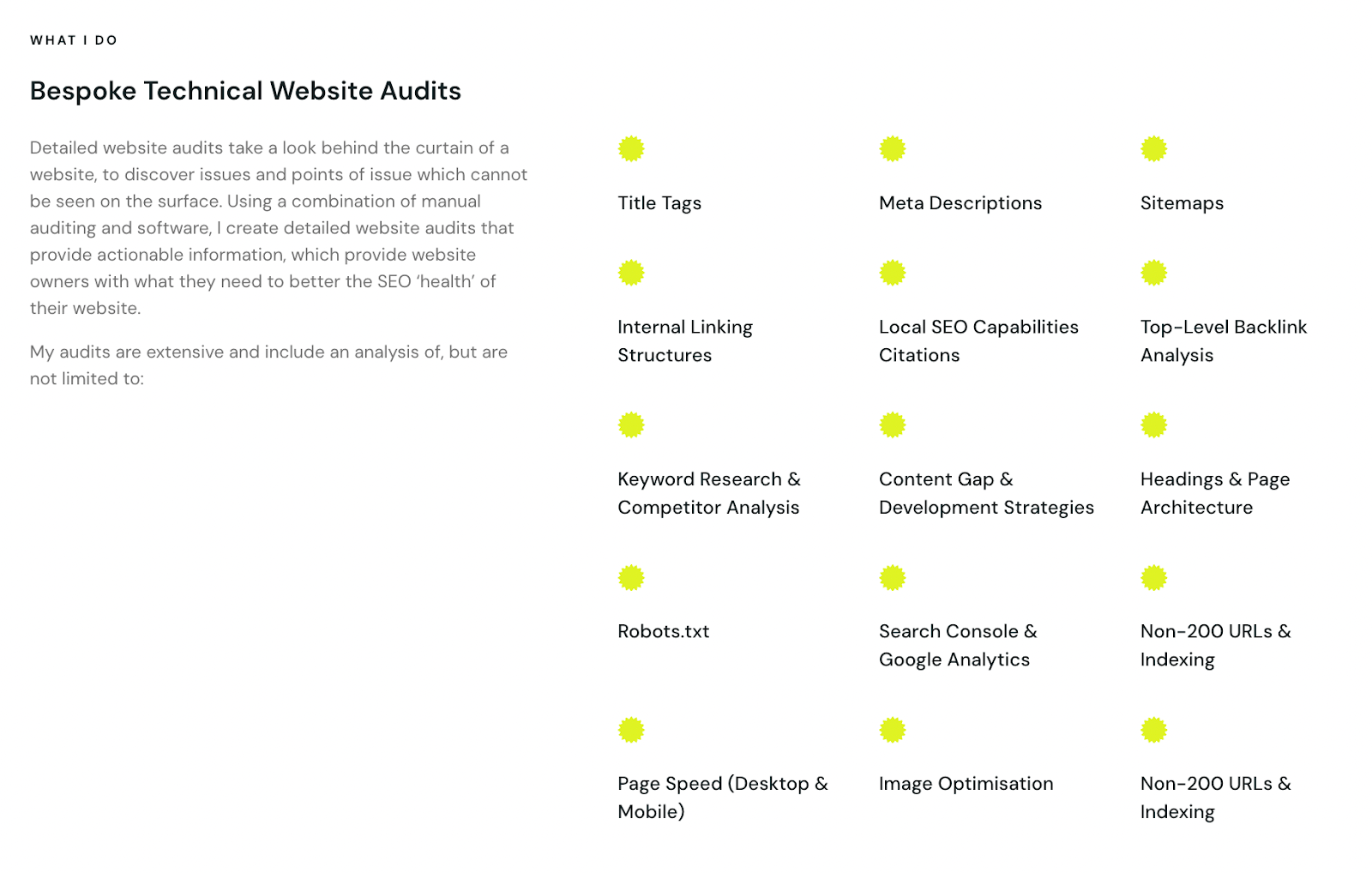
2. Monetize your audience
I’ve worked hard to grow my audience over the past decade and I’m now sitting at almost 20,000 followers across my platforms. And, with a bigger audience comes more opportunities.
I know a lot of freelancers cringe at the thought of baring their souls online, but I know plenty of freelancers who have grown huge followings by keeping things professional and sharing work-related content on social media—I think one of my favorite niche examples is Kat Norton (a.k.a. Miss Excel) who turned spreadsheets into something… fun.
If you’ve managed to build a social media following, email list, or any other kind of audience, there are a couple of ways you can leverage that for additional revenue.
Affiliate marketing
Partnering with brands relevant to your audience lets you earn a commission by recommending tools, courses, or products you believe in. This might be software you use as a freelancer or business tools that support your lifestyle—whatever the motive, you can weave affiliate links into social posts, newsletters, and your website.
Sponsored content and brand partnerships
As my audience grew, I started to get more inquiries from brands who wanted to partner with me to reach my followers. I’ve run a few sponsored call-outs in the Friday Freelance Tips newsletter over the past couple of months and have partnered with brands to share their products on social media.
This can be a great way to earn one-off revenue or you can turn it into an ongoing partnership or ambassadorship for something a bit more permanent.
Katelyn Bourgoin partners with relevant brands and gives them a shoutout in her popular newsletter.

3. Create and sell digital products
Way back in the day, I wrote an 85-page ebook about storytelling and sold about three copies. It wasn’t a great result, but it opened my eyes to the possibilities of selling digital products.
Since then, I’ve gone on to create workbooks, downloads, courses, and toolkits, all of which have generously cushioned my income. This year alone, I’ve made almost $30,000 from selling courses and digital products.
Sure, there’s a bit of upfront effort involved and you’ll never really know for certain if they’ll take off, but they can become great sources of passive income. My courses tick away in the background while I focus on creating content for my other clients.
Here are a few high-impact digital products to consider.
Ebooks
If you’re knowledgeable about a specific topic, package your insights into an ebook. This could be a how-to guide, a step-by-step tutorial, or even a collection of tips you’ve developed throughout your freelance journey.
You can use past client conversations to come up with ideas. For example, if clients regularly ask you what your process is for creating highly technical how-to content, you can write an ebook that walks them through that process.
This ebook shows readers how to communicate professionally.
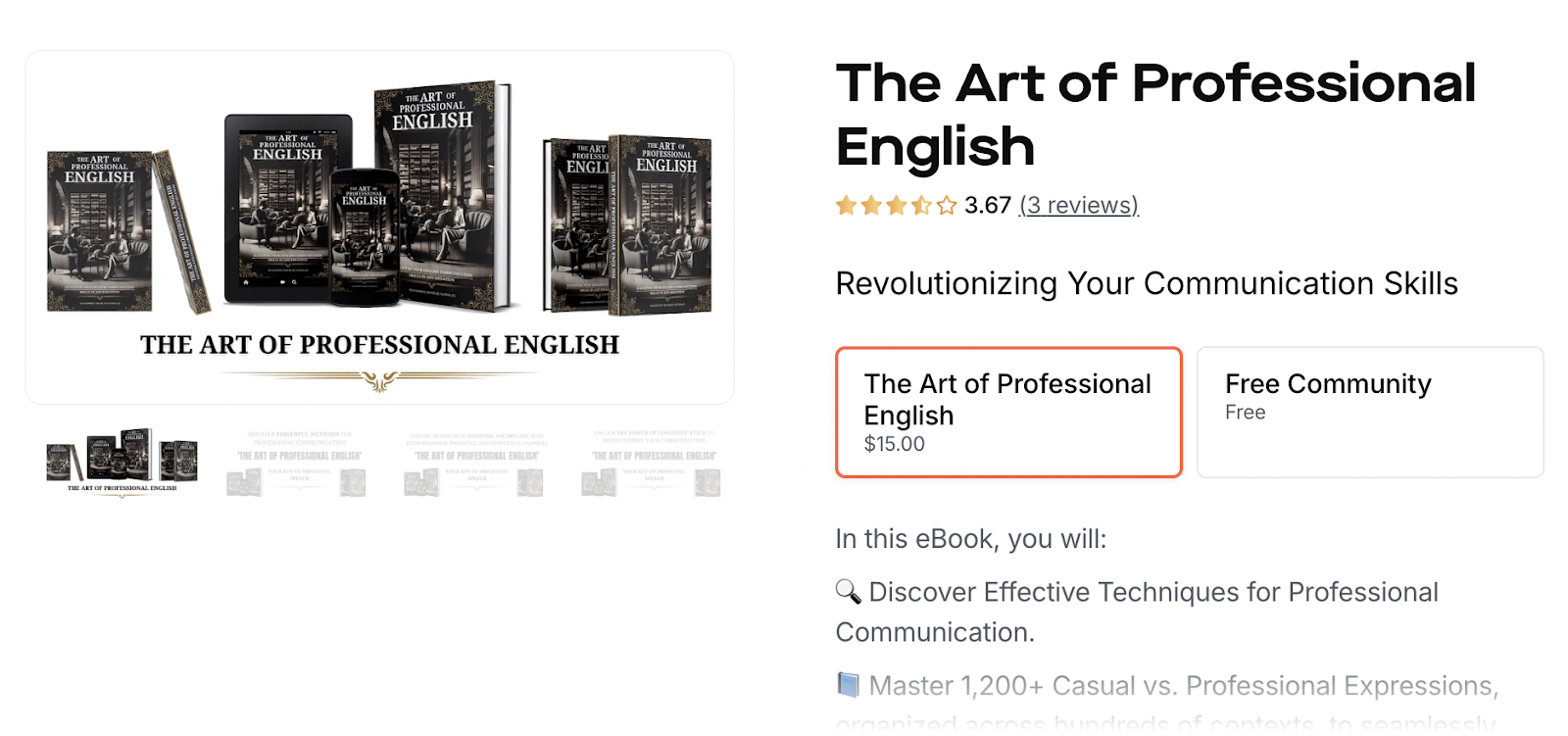
Training manuals and toolkits
Lots of people want ready-to-use resources without the hassle of learning a new tool or setting it up from scratch themselves.
This might be something like a content calendar for social media managers, a budgeting toolkit for freelancers, or a pitch template for creatives. Think about the tools and templates you use daily and package them into something your audience can buy and immediately put to use.
For example, one of my most popular digital products is a Notion dashboard freelancers can use to track their pitches.
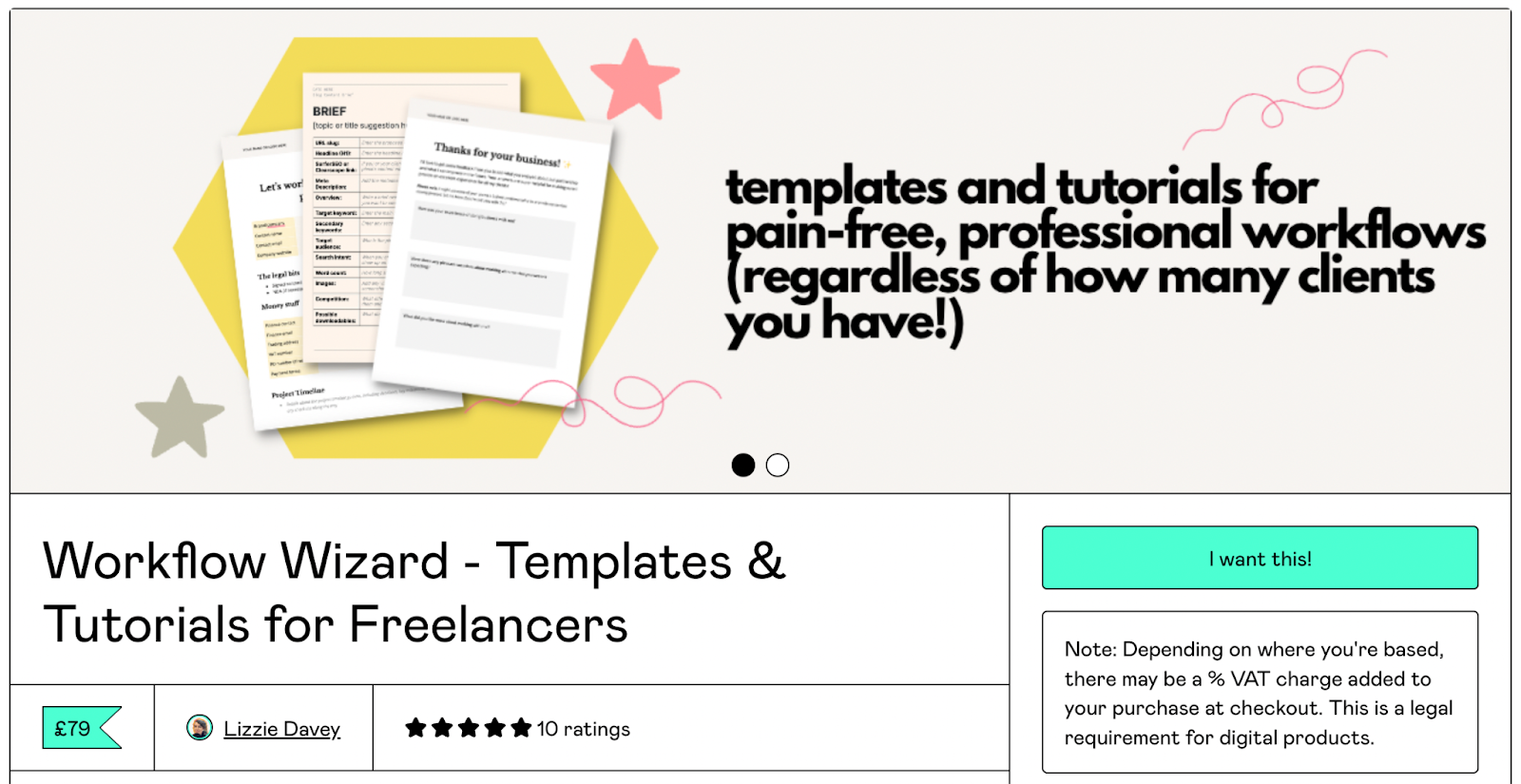
Worksheets and printables
PDFs are low-cost and easy to make, which makes them excellent add-ons or entry-level products. You can create printable planners, checklists, or worksheets to help your audience achieve specific goals.
These info products are really easy to distribute and are a great addition to your services for clients who can’t afford your high-ticket offers.
For example, if one of your services involves creating an Instagram content calendar for clients, you could sell a low-ticket printable calendar they can complete themselves if they don’t have the budget to work directly with you.
Online courses
Online courses are a bit more labor intensive (and a bigger upfront commitment), but they can also bring in bigger returns.
I’ve created and launched almost 10 courses over the past six years, each of which guides participants through a certain skill set. The great thing about courses is they boost your authority in your niche and they can demand a higher price tag than, say, a digital download or an ebook.
4. Teach what you know
The great thing about teaching is you only need to be one step ahead of the person you’re teaching. Over the years, I’ve added a handful of different ways people can learn from me, including one-to-one sessions and workshops.
Similarly to consulting, you can pass on your knowledge, which ultimately grows your expertise in your industry.
Here are some ways you can teach what you know.
One-on-one coaching
One of the most successful “products” I launched recently was my one-to-one freelance Q&A sessions. People could book an hour of my time and ask me anything they wanted about freelancing. You can do this for anything you’re knowledgeable about.
You can offer one-on-one coaching sessions where you guide clients through specific challenges, such as coaching marketers on advanced skills or building out a content strategy.
Freelancer Jenni Gritters also offers coaching packages for fellow small business owners.
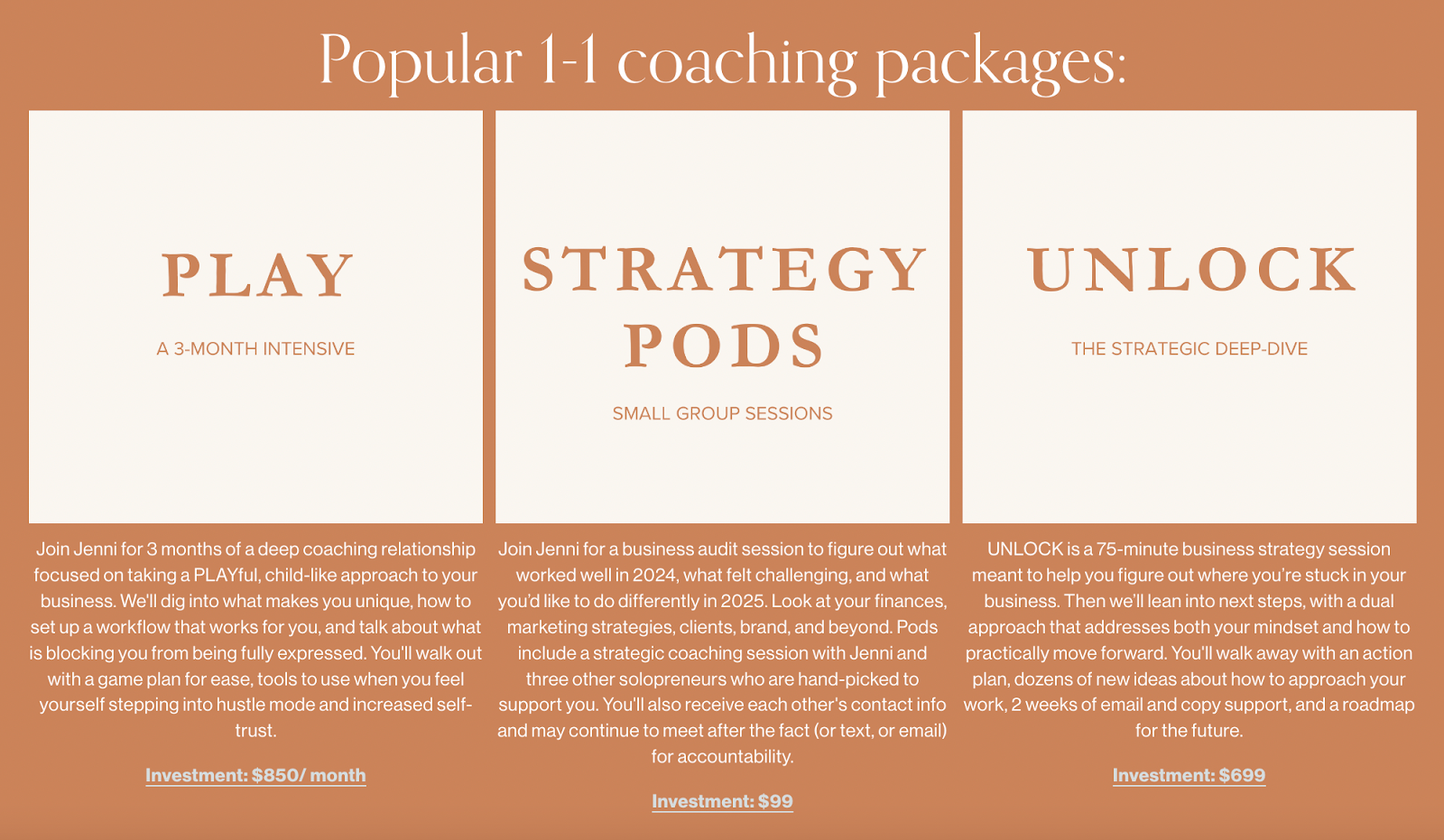
Masterclasses
I’ve already covered courses, but masterclasses are a good way to offer potted insights into your skills and knowledge. You can host one-off masterclasses that people sign up for individually or offer more extensive multi-week masterclasses.
This is a great opportunity to deep dive into a specific topic and lead into your additional, high-ticket services.
This masterclass shows Amazon users how to master Amazon FBA.
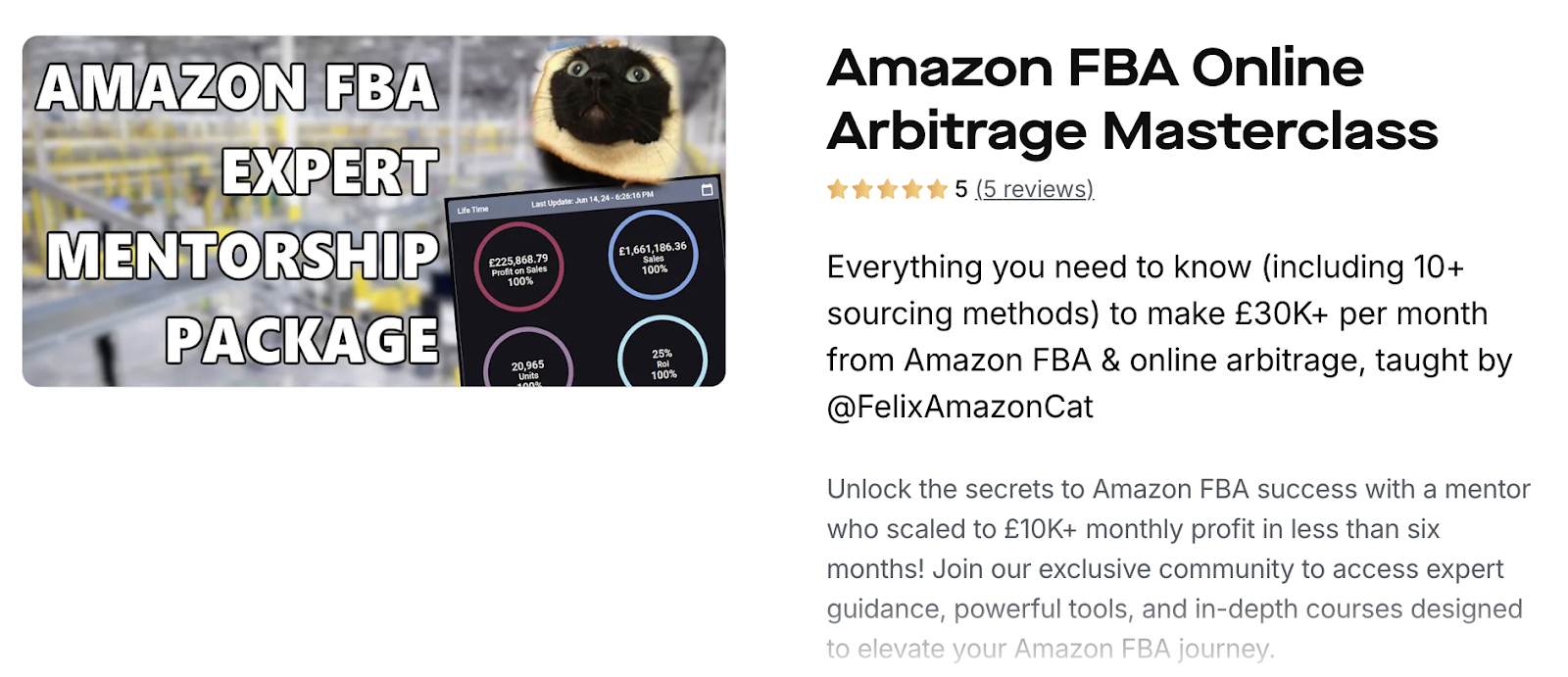
Paid communities
Sometimes people want to learn in a group situation. They can bounce ideas off others and generally feel a sense of togetherness. A paid community brings together like-minded people and gives you a space to host exclusive content, Q&A sessions, and live calls.
Think about what value you can bring to the group each month. For example, you could run a paid community for your fellow freelancers where you share fresh job postings and tips.
SaaS University is a community for SaaS founders. It’s full of useful courses, discussions, and resources.

Group training and masterminds
If you prefer working with groups, what about group training programs or masterminds? These offer a high-touch experience without the need for one-on-one time and let you make a bigger impact by helping multiple people simultaneously.
Freelance editor Erica Schneider has created a group program for solopreneurs.

How to get started with Whop and create your multiple income streams
Ready to take your freelance business to the next level? Whop was designed to make setting up and managing different revenue streams a breeze because you can do it all from one central hub - your whop.
Here’s how to get started.
- Create your whop
Start by setting up your whop. This will act as the online hub for business, and you can run your entire businesses from one central place. - Add your freelance services
Add the apps you need to build out your whop, starting with your main offering. For example, if you're a freelance writer, start with calendar app to take booking with potential clients, links board app to showcase your published works, and the videos app to take video calls.
You can create a booking page, set pricing tiers, and adjust your availability, making it simple for clients to book with you directly. - Diversify with digital products
Have templates, guides, or resources your clients love? List your resources, one-off purchases, or subscription-based offers for recurring income. Whop has a ton of built-in promotional tools you can use to connect with both new and existing clients. - Add memberships and paid communities
Take it further by creating a paid membership or community. Whop’s membership features let you engage with your audience and offer exclusive content for a monthly fee. - Host paid workshops and webinars
Whop makes it easy to host paid events, live workshops, and webinars right from your hub.
The idea behind your whop is that you’re not just creating a hub for your freelance services. You’re also building a central place where clients can see all the things you offer, and budding freelancers can follow in your footsteps by gaining access to your knowledge in a private community setting.
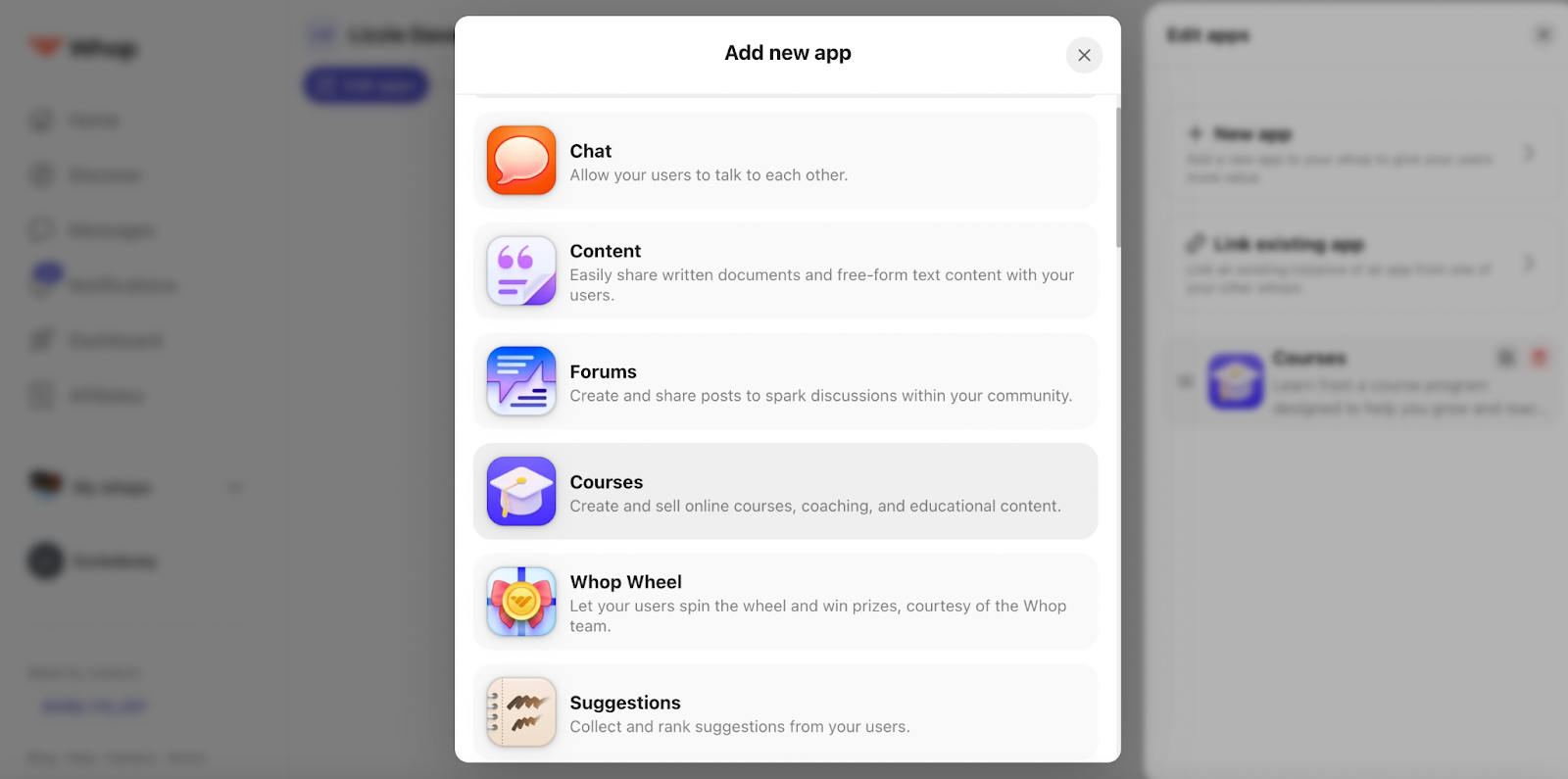
The platform makes it easy to manage multiple income streams under one roof, which is ideal if you want the freedom to experiment, earn, and expand without having to juggle multiple platforms.
Ready to maximize your freelance earnings with Whop? Create your whop and make multiple income streams.


